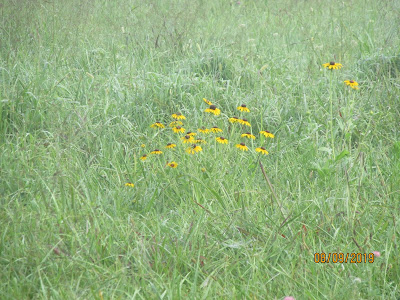At 7:15 this evening the dooryard still pulsed with heat.
There has been no rain this month; heavy dew and occasional morning mist have provided the only refreshing moisture.
We open the front door early, before the sun edges through the treeline spreading bands of shimmering light over the newly shorn meadow.
Within an hour we must close the door, draw the blinds, pull the heavy linen curtains across the windows blocking even the slender splinters of golden light that make their way through the slats of the blinds.
The cats come in, wet-pawed from their forays of exploration through the meadow.
Seedlings and new tranplants must be hand-watered morning and evening; I have lost some to the inhospitable weather.
Heat was still trapped at the west end of the house as I finished watering.
The sun, sliding away, cast reflections toward the house, even as dusk advanced.
Early morning mist.
Spider webs shimmered in tall grass the morning before the hay was cut.
We have hoped for rain on some of these misty mornings, but always the sky has cleared, the mist 'burned off.'
A single clump of brown-eyed Susans stood in the path of the mowing machine.
August has brought various garden frustrations in addition to the drought.
It took some research to learn what was attacking the coneflower seedlings which had previously been thriving.
The voracious black caterpillars are the progeny of the silvery checker-spot butterfly, a species I hadn't noticed before. I had been grimly picking off and squashing the caterpillars before resorting to a google search. Their identification presents a dilemma. I want to encourage butterflies, but I am annoyed at the destruction of the coneflowers raised from seed, cosseted and transplanted into the garden.
Seedlings of asclepia incarnata were likewise flourishing before I found the stems coated with the sticky orange presence of aphids. I scraped off the first invasion, sprayed the second batch of intruders with a soap and water solution.
On discovering several monarch caterpillars happily munching leaves I've desisted in efforts to be rid of the aphids, not wanting to unwittingly spoil the leaves for monarch consumption.
A grasshopper finds shade in the lemon verbena.
Jim, weary of listening to me fret about the clematis plants languishing in their pots constructed what he calls a McGyver fence.
I questioned the name and was informed that 'McGyver' was a fictional character who could contrive to make or mend all sorts of situations with whatever oddments came to hand.
Accordingly, the little fence has a personality of its own, but appears to be serving the purpose.
I labored for several mornings, prying up sod and removing stones along the fence til Jim took pity and loosened the hard-packed soil with the tiller. I forked in a bagged compost to create an encouraging environment and carefully set four clematis in place--the two that survived from my Spring Hills purchase and two moved last fall from the farm.
Extracting clematis candida from its tub proved to be a delicate operation.
The plant had become 'pot bound' and once coaxed from the big tub, I sat on the ground for nearly half an hour gently unraveling the mass of stringy roots before carefully settling the plant into a deep hole lined with compost.
New growth is responding to careful watering with tendrils beginning to explore the lower rail of the fence.
I planted a dwarf butterfly bush at each end of the fence after giving them a severe pruning. I've found that even plants recommended for pot culture cease to thrive after a bit. These bloomed and were pretty earlier in the season, but had begun to droop. Both are responding to their new situation.
I selected the largest of my seedlings of balloon flower, foxgloves and four rather frail seedlings of pale coneflower to plant in front of the clematis, surrounding each plant with mulch and short plastic stakes which I hoped would discourage the cats.
Sadly, between hot weather and interested feline proddings I lost the frailest of the foxgloves, all that remained of my crop of the variety Spanish Peaks.
The pale coneflowers are struggling and I dare not predict their fate.
Looking back today through last August's journal posts I see that we were lamenting constant rain!
Jim was attempting to break ground for the new house, I was doggedly packing our household goods.
This is our 10th summer in Kentucky.
Each growing season has been different--some more challenging than others.











Here you are having no rain and we are having LOTS, although, we did need it as we had been rather dry for quite awhile. We had more rain again this morning, but the sky is blue and there is a breeze blowing. It is hot outside though and I'm indoors doing some straightening, cleaning, etc.
ReplyDeleteCaterpillars of butterflies do tend to eat their favorite treats from our gardens. Your clematis are pretty. Hope you get some rain soon.
Love, hugs & prayers for the two of you and your critters ~ FlowerLady
Rainey; Our lack of control over the weather keeps us very humble! I fear my 2nd planting of cukes and tomatoes has been dry too long to revive even with a 'good' rain and cooler temps.
DeleteI am encouraged about the clematis as I water them every night after sundown--and in the morning early if they seem to need it.